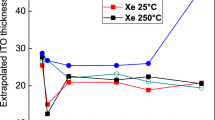Abstract
The results of the investigation of the transmission of low-energy electrons through 8-nm-thick films of tin(IV) phthalocyanine oxide (SnOPc) on the surface of the oxidized silicon substrate are presented. The procedure of detecting the reflection of testing low-energy electron beam from the surface was implemented using the very low-energy electron diffraction (VLEED) technique in the total current spectroscopy (TCS) mode with a change in the incident electron beam energy from 0 to 25 eV. The structure of maxima in the total current spectra of SnOPc films was established and the variation in intensities of the maxima of total current spectra emitted from the deposited SnOPc film and (SiO2)n-Si substrate during an increase in the thickness of the organic coating to 8 nm was analyzed. With such an increase in the thickness of the organic coating, the work function of the surface increases by 0.7 eV, which corresponds to the transfer of the electron density from the (SiO2)n-Si substrate to the SnOPc film. Optical absorption spectra of SnOPc films were measured. The absorption spectra were compared with the spectra measured by the TCS method for the SnOPc films and the films of molecules of oxygen-free metal phthalocyanine.
Similar content being viewed by others
References
L. Grzadziel, M. Krzywiecki, H. Peisert, T. Chassé, and J. Szuber, Org. Electron. 13(10), 1873 (2012).
J. Ren, Sh. Meng, Y.-L. Wang, X.-C. Ma, Q.-K. Xue, and E. Kaxiras, J. Chem. Phys. 134, 194706 (2011).
M. Marks, S. Sachs, C. H. Schwalb, A. Schöll, and U. Höfer, J. Chem. Phys. 139(12), 124701 (2013).
J.L. Brédas and A. J. Heeger, Chem. Phys. Lett. 217, 507 (1994).
S. Godlewski and M. Szymonski, Int. J. Mol. Sci. 14(2), 2946 (2013).
A. S. Komolov, E. F. Lazneva, C. A. Pshenichnyuk, A. A. Gavrikov, N. S. Chepilko, A. A. Tomilov, N. B. Gerasimova, A. A. Lezov, and P. S. Repin, Semiconductors 47(7), 956 (2013).
D. Song, F. Zhu, B. Yu, L. Huang, Y. Geng, and D. Yan, Appl. Phys. Lett. 92, 143303 (2008).
F. Babudri, G. M. Farinola, F. Naso, and R. Ragni, Chem. Commun. (Cambridge) 10, 1003 (2007).
S. Bubel, A. Ringk, P. Strohriegl, and R. Schmechel, Physica E (Amsterdam) 44(10), 2124 (2012).
S. S. Karpova, V. A. Moshnikov, A. I. Maksimov, S. V. Myakin, and N. E. Kazantseva, Semiconductors 47(8), 1026 (2013).
A. N. Aleshin, I. P. Shcherbakov, V. N. Petrov, and A. N. Titkov, Org. Electron. 12(8), 1285 (2011).
F. Meng, X. Yan, Y. Zhu, and P. Si, Nanoscale Res. Lett. 8, 179 (2013).
A. Modelli, D. Jones, and S. A. Pshenichnyuk, J. Phys. Chem. C 114, 1725 (2010).
A. S. Komolov, E. F. Lazneva, S. N. Akhremtchik, N. S. Chepilko, and A. A. Gavrikov, J. Phys. Chem. C 117(24), 12633 (2013).
S. Qu, Y. Gao, and C. Zhao, Chem. Phys. Lett. 367, 767 (2003).
A. S. Komolov and P. J. Moeller, Appl. Surf. Sci. 212–213, 497 (2003).
A. S. Komolov and P. J. Moeller, Colloids Surf., A 239, 49 (2004).
I. Bartos, Prog. Surf. Sci. 59, 197 (1998).
S. A. Pshenichnyuk, A. V. Kukhto, I. N. Kukhto, and A. S. Komolov, Tech. Phys. 56(6), 754 (2011).
S. A. Pshenichnyuk and A. S. Komolov, J. Phys. Chem. A 116(1), 761 (2012).
S. A. Komolov, E. F. Lazneva, and A. S. Komolov, Tech. Phys. Lett. 29(12), 974 (2003).
T. Graber, F. Forster, A. Schoell, and F. Reinert, Surf. Sci. 605, 878 (2011).
L. Yan and Y. Gao, Thin Solid Films 417, 101 (2002).
I. Hill, D. Milliron, J. Schwartz, and A. Kahn, Appl. Surf. Sci. 166, 354 (2000).
A. S. Komolov, S. N. Akhremtchik, and E. F. Lazneva, Spectrochim. Acta, Part A 798, 708 (2011).
Y. Stöhr, NEXAFS Spectroscopy (Springer-Verlag, Berlin, 2003).
Author information
Authors and Affiliations
Corresponding author
Additional information
Original Russian Text © A.S. Komolov, E.F. Lazneva, N.B. Gerasimova, Yu.A. Panina, A.V. Baramygin, Ya.V. Akhremchik, A.V. Povolotskiy, 2014, published in Fizika Tverdogo Tela, 2014, Vol. 56, No. 12, pp. 2464–2467.
Rights and permissions
About this article
Cite this article
Komolov, A.S., Lazneva, E.F., Gerasimova, N.B. et al. Transmission of low-energy electrons through ultrathin layers of tin(IV) phthalocyanine oxide. Phys. Solid State 56, 2556–2560 (2014). https://doi.org/10.1134/S1063783414120178
Received:
Published:
Issue Date:
DOI: https://doi.org/10.1134/S1063783414120178




